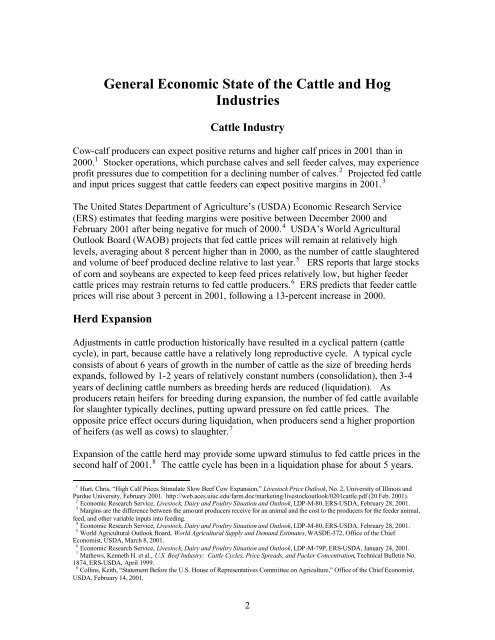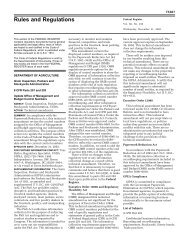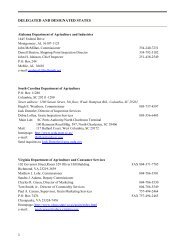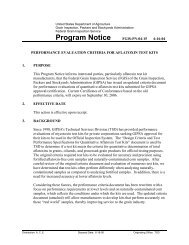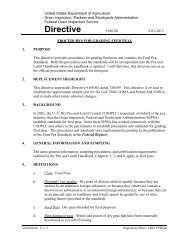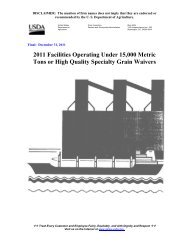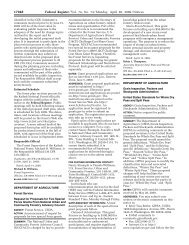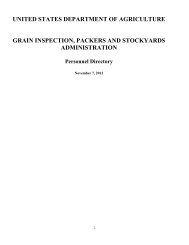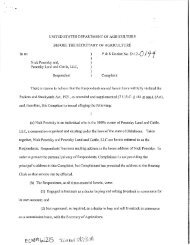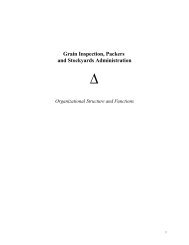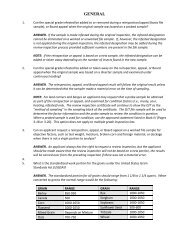Assessment of the Cattle and Hog Industries Calendar Year 2000
Assessment of the Cattle and Hog Industries Calendar Year 2000
Assessment of the Cattle and Hog Industries Calendar Year 2000
You also want an ePaper? Increase the reach of your titles
YUMPU automatically turns print PDFs into web optimized ePapers that Google loves.
General Economic State <strong>of</strong> <strong>the</strong> <strong>Cattle</strong> <strong>and</strong> <strong>Hog</strong><br />
<strong>Industries</strong><br />
<strong>Cattle</strong> Industry<br />
Cow-calf producers can expect positive returns <strong>and</strong> higher calf prices in 2001 than in<br />
<strong>2000</strong>. 1 Stocker operations, which purchase calves <strong>and</strong> sell feeder calves, may experience<br />
pr<strong>of</strong>it pressures due to competition for a declining number <strong>of</strong> calves. 2 Projected fed cattle<br />
<strong>and</strong> input prices suggest that cattle feeders can expect positive margins in 2001. 3<br />
The United States Department <strong>of</strong> Agriculture’s (USDA) Economic Research Service<br />
(ERS) estimates that feeding margins were positive between December <strong>2000</strong> <strong>and</strong><br />
February 2001 after being negative for much <strong>of</strong> <strong>2000</strong>. 4 USDA’s World Agricultural<br />
Outlook Board (WAOB) projects that fed cattle prices will remain at relatively high<br />
levels, averaging about 8 percent higher than in <strong>2000</strong>, as <strong>the</strong> number <strong>of</strong> cattle slaughtered<br />
<strong>and</strong> volume <strong>of</strong> beef produced decline relative to last year. 5 ERS reports that large stocks<br />
<strong>of</strong> corn <strong>and</strong> soybeans are expected to keep feed prices relatively low, but higher feeder<br />
cattle prices may restrain returns to fed cattle producers. 6 ERS predicts that feeder cattle<br />
prices will rise about 3 percent in 2001, following a 13-percent increase in <strong>2000</strong>.<br />
Herd Expansion<br />
Adjustments in cattle production historically have resulted in a cyclical pattern (cattle<br />
cycle), in part, because cattle have a relatively long reproductive cycle. A typical cycle<br />
consists <strong>of</strong> about 6 years <strong>of</strong> growth in <strong>the</strong> number <strong>of</strong> cattle as <strong>the</strong> size <strong>of</strong> breeding herds<br />
exp<strong>and</strong>s, followed by 1-2 years <strong>of</strong> relatively constant numbers (consolidation), <strong>the</strong>n 3-4<br />
years <strong>of</strong> declining cattle numbers as breeding herds are reduced (liquidation). As<br />
producers retain heifers for breeding during expansion, <strong>the</strong> number <strong>of</strong> fed cattle available<br />
for slaughter typically declines, putting upward pressure on fed cattle prices. The<br />
opposite price effect occurs during liquidation, when producers send a higher proportion<br />
<strong>of</strong> heifers (as well as cows) to slaughter. 7<br />
Expansion <strong>of</strong> <strong>the</strong> cattle herd may provide some upward stimulus to fed cattle prices in <strong>the</strong><br />
second half <strong>of</strong> 2001. 8 The cattle cycle has been in a liquidation phase for about 5 years.<br />
1 Hurt, Chris, “High Calf Prices Stimulate Slow Beef Cow Expansion,” Livestock Price Outlook, No. 2, University <strong>of</strong> Illinois <strong>and</strong><br />
Purdue University, February 2001. http://web.aces.uiuc.edu/farm.doc/marketing/livestockoutlook/0201cattle.pdf (20 Feb. 2001).<br />
2 Economic Research Service, Livestock, Dairy <strong>and</strong> Poultry Situation <strong>and</strong> Outlook, LDP -M-80, ERS-USDA, February 28, 2001.<br />
3 Margins are <strong>the</strong> difference between <strong>the</strong> amount producers receive for an animal <strong>and</strong> <strong>the</strong> cost to <strong>the</strong> producers for <strong>the</strong> feeder animal,<br />
feed, <strong>and</strong> o<strong>the</strong>r variable inputs into feeding.<br />
4 Economic Research Service, Livestock, Dairy <strong>and</strong> Poultry Situation <strong>and</strong> Outlook, LDP -M-80, ERS-USDA, February 28, 2001.<br />
5 World Agricultural Outlook Board, World Agricultural Supply <strong>and</strong> Dem<strong>and</strong> Estimates, WASDE-372, Office <strong>of</strong> <strong>the</strong> Chief<br />
Economist, USDA, March 8, 2001.<br />
6 Economic Research Service, Livestock, Dairy <strong>and</strong> Poultry Situation <strong>and</strong> Outlook, LDP -M-79P, ERS-USDA, January 24, 2001.<br />
7 Ma<strong>the</strong>ws, Kenneth H. et al., U.S. Beef Industry: <strong>Cattle</strong> Cycles, Price Spreads, <strong>and</strong> Packer Concentration, Technical Bulletin No.<br />
1874, ERS-USDA, April 1999.<br />
8 Collins, Keith, “Statement Before <strong>the</strong> U.S. House <strong>of</strong> Representatives Committee on Agriculture,” Office <strong>of</strong> <strong>the</strong> Chief Economist,<br />
USDA, February 14, 2001.<br />
2


